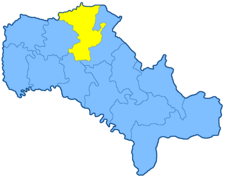
The Podolia Governorate, also known as the Podillia Governorate, was a province (guberniya) of the Southwestern Krai of the Russian Empire. The Podolia Governorate bordered the Volhynian Governorate to the north, the Kiev Governorate to the east, the Kherson Governorate to the southeast, the Bessarabia Governorate to the south, and Austria to the west. Its administrative centre was Kamenets-Podolsky (Kamianets-Podilskyi), which later moved to Vinnitsa (Vinnytsia). The governorate covered areas of Ukraine's partially Khmelnytskyi and most of Vinnytsia Oblasts, along with the fractionally recognised state of Transnistria.
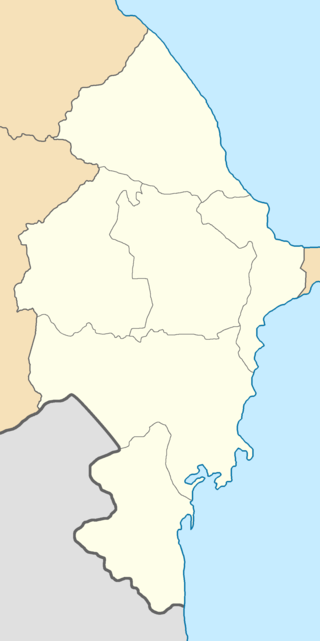
The Baku Governorate, known before 1859 as the Shemakha Governorate, was a province (guberniya) of the Caucasus Viceroyalty of the Russian Empire, with its center in the booming metropolis and Caspian Sea port of Baku. Area (1897): 34,400 sq. versts, population (1897): 789,659. The Baku Governorate bordered Persia to the south, the Elizavetpol Governorate to the west, the Dagestan Oblast to the north, and the Baku gradonachalstvo to the east on the Absheron Peninsula.

The Kherson Governorate, known until 1803 as the Nikolaev Governorate, was a province (guberniya) of the Russian Empire, with its centеr in Kherson. The governorate encompassed 71,936 square kilometres (27,775 sq mi) in area and had a population of 2,733,612 inhabitants. At the time of the census in 1897, it bordered the Podolia Governorate to the northwest, the Kiev Governorate to the north, the Poltava Governorate to the northeast, the Yekaterinoslav Governorate to the east, the Taurida Governorate to the southeast, the Black Sea to the south, and the Bessarabia Governorate to the west. It roughly corresponds to what is now most of Mykolaiv, Kirovohrad and Odesa Oblasts and some parts of Kherson and Dnipropetrovsk Oblasts.

The Vilna Governorate was a governorate of the Northwestern Krai of the Russian Empire. In 1897, the governorate covered the area of 41,907.9 square kilometres (16,180.7 sq mi) and a population of 1,591,207 inhabitants. The governorate was defined by the Minsk Governorate to the south, the Grodno Governorate to the southwest, the Suwałki Governorate to the west, the Kovno and Courland Governorates to the north, and the Vitebsk Governorate to the east. The administrative centre was located in the city of Vilna. The city also served as the administrative centre of the Vilna Governorate-General, which existed until 1912. The area roughly corresponded to the Vilnius Region, which was later occupied by Germany, Bolsheviks, and Poland.

The Tiflis Governorate was a province (guberniya) of the Caucasus Viceroyalty of the Russian Empire with its administrative center in Tiflis. In 1897, it constituted 44,607 sq. kilometres in area and had a population of 1,051,032 inhabitants. The Tiflis Governorate bordered the Elizavetpol Governorate to the southeast, the Erivan Governorate to the south, the Kars Oblast to the southwest, the Batum Oblast to the west, the Kutaisi Governorate to the northwest, the Terek Oblast to the north, the Dagestan Oblast to the northeast, and after 1905, the Zakatal Okrug to the east. The governorate covered areas of central and southeastern Georgia, the partially recognised state of South Ossetia, most of the Lori Province of Armenia, small parts of northwestern Azerbaijan, and a minuscule southern part of Ingushetia within Russia.

The Volhynian Governorate or Volyn Governorate was a province (guberniya) of the Southwestern Krai of the Russian Empire. It consisted of an area of 71,736 square kilometres (27,697 sq mi) and a population of 2,989,482 inhabitants. The governorate bordered the Grodno and Minsk Governorates to the north, the Kiev Governorate to the east, the Podolia Governorate to the south, the Lublin and Siedlce Governorates, and after 1912, the Kholm Governorate and Austria to the west. The administrative centre was Zhitomir, until 1804, its administrative centre was located in Novograd-Volynsky. It corresponded to most of Volyn, Rivne and Zhytomyr Oblasts of Ukraine and some parts of Brest and Gomel Regions of Belarus.
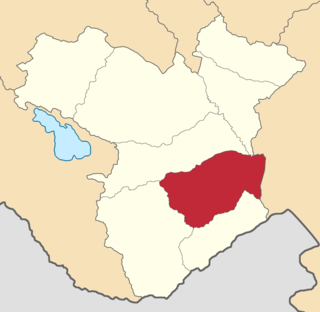
The Shusha uezd was a county (uezd) of the Elizavetpol Governorate of the Russian Empire, and then of the Ganja Governorate of Azerbaijan Democratic Republic with its center in Shusha in 1840–1921.

The Elizavetpol uezd, also known as the Ganja uezd after 1918, was a county (uezd) of the Elizavetpol Governorate of the Russian Empire, and later of the Azerbaijan Democratic Republic and Azerbaijan SSR until its formal abolition in 1929. The area of the Elizavetpol uezd corresponds to the modern-day Gadabay, Shamkir, Dashkasan, Goygol, and Samukh districts of Azerbaijan.
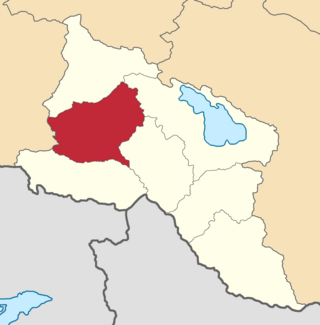
The Etchmiadzin uezd was a county (uezd) of the Erivan Governorate of the Caucasus Viceroyalty of the Russian Empire. The uezd bordered the Alexandropol uezd to the north, the Nor Bayazet uezd to the east, Erivan uezd to the north, the Surmalu uezd to the south, and the Kars Oblast to the west. It included all of the Armavir Province and most of the Aragatsotn Province of present-day Armenia. The administrative centre of the county was Vagorshapat (Vagharshapat), also referred to as Etchmiadzin—the administrative capital of the Armenian Apostolic Church.
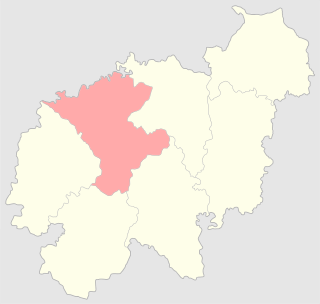
The Vilna uezd was a county (uezd) of the Vilna Governorate of the Russian Empire, with the administrative centre in Vilna. The uezd was bordered by the Sventsyany uezd to the east, the Oshmyany and Lida uezds to the south, the Troki uezd to the west, and the Vilkomir uezd of the Kovno Governorate to the north. The district covered the area of modern Vilnius County of Lithuania.
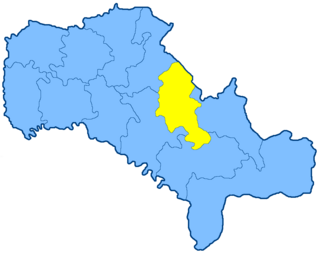
The Bratslav uezd was a county (uezd) of the Podolian Governorate of the Russian Empire. It bordered the Lipovets uezd of the Kiev Governorate to the north, the Gaysin uezd to the east, the Olgopol uezd to the south, the Yampol uezd to the southwest, and the Vinnitsa uezd to the north. The Bratslav uezd was eponymously named for its administrative center, Bratslav.
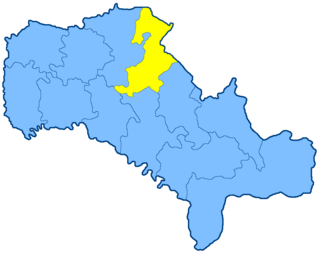
The Vinnitsa uezd was a county (uezd) of the Podolian Governorate of the Russian Empire. The uezd bordered the Zhitomir uezd of the Volhynian Governorate to the north, the Berdichev uezd of the Kiev Governorate to the northeast, the Bratslav uezd to the east, the Yampol uezd to the south, and the Litin uezd to the west. The administrative centre of the county was Vinnitsa. The county composed most of Vinnytsia Raion of contemporary Ukraine.
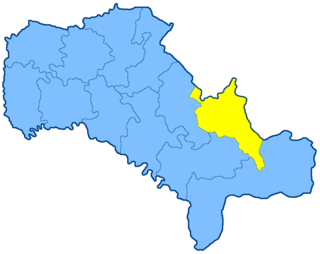
The Gaysin uezd was a county (uezd) of the Podolian Governorate of the Russian Empire, with its administrative centre in Gaysin. The area of the Gaysin uezd covered the area of modern-day Haisyn Raion.

The Kamenets-Podolsky uezd was a county (uezd) of the Podolian Governorate of the Russian Empire. The uezd bordered the Proskurov uezd to the north, the Ushitsa uezd to the east, the Khotin uezd to the south, and Austria to the west. Its administrative centre of the county was Kamenets-Podolsky. The county covered most of the area of Kamianets-Podilskyi Raion.
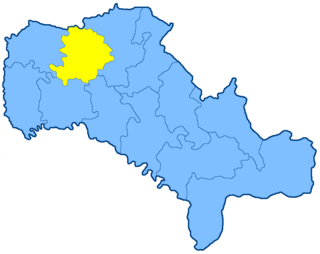
The Letichev uezd was a county (uezd) of the Podolian Governorate of the Russian Empire. The uezd bordered the Starokonstantinov uezd of the Volhynian Governorate, the Litin uezd to the east, the Mogilev uezd to the southeast, the Ushitsa uezd to the south, and the Proskurov uezd to the west. The area of the uezd encompassed most of Khmelnytskyi Raion of Ukraine. The administrative centre of the county was Letichev.
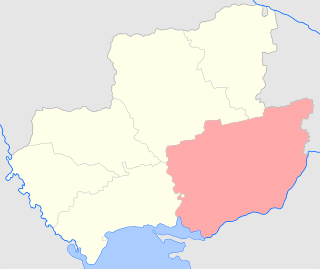
The Kherson uezd was a county (uezd) of the Kherson Governorate of the Russian Empire, and then of the Ukrainian People's Republic and the Ukrainian SSR until the administrative reform of 1923. The uezd bordered the Odessa uezd to the west, the Elisavetgrad uezd to the northwest, the Aleksandriya uezd to the north, the Verkhnedneprovsk and Yekaterinoslav uezds of the Yekaterinoslav Governorate to the east, the Melitopol and Dneprovsk uezds of the Taurida Governorate, and the Black Sea to the south. The district was eponymously named for its administrative center, Kherson.

The Aleksandriya uezd was a county (uezd) of the Kherson Governorate of the Russian Empire. It bordered the Chigirin uezd of the Kiev Governorate to the north, the Kremenchug uezd to the northeast, the Verkhnedneprovsk uezd of the Yekaterinoslav Governorate to the east, the Kherson uezd to the south, and the Elisavetgrad uezd to the west. The Aleksandriya uezd was eponymously named for its administrative center, Aleksandriya.

The Elisavetgrad uezd was a county (uezd) of the Kherson Governorate of the Russian Empire, with its administrative center in Yelisavetgrad. It bordered the Zvenigorodka and Chigirin uezds of the Kiev Governorate to the north, the Aleksandriya uezd to the east, the Kherson uezd to the south, and the Ananev uezd to the west. The uezd corresponded to Kirovohrad and Mykolaiv Oblasts.

The Odessa uezd was a county (uezd) of the Kherson Governorate of the Russian Empire. The uezd bordered the Tiraspol and Ananev uezds to the north, the Elisavetgrad uezd to the northeast, the Kherson uezd to the east, the Black Sea to the south, and the Akkerman uezd of the Bessarabia Governorate to the west. The administrative centre of the county was Odessa (Odesa).
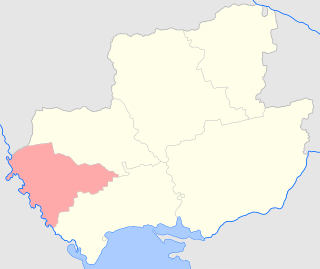
The Tiraspol uezd was a county (uezd) of the Kherson Governorate of the Russian Empire. The uezd bordered the Balta uezd of the Podolia Governorate to the north, the Ananev uezd to the east, the Odessa uezd to the south, and the Akkerman and Bendery uezd of the Bessarabia Governorate to the west. The administrative centre of the county was Tiraspol. The area of the Tiraspol uezd corresponded to most of Odesa Oblast and the breakaway territory of Transnistria, which is a part of Moldova.
